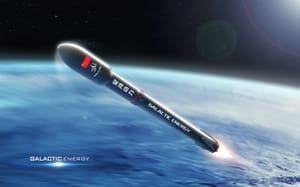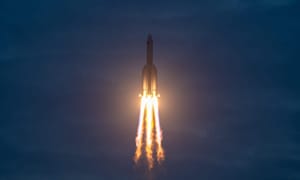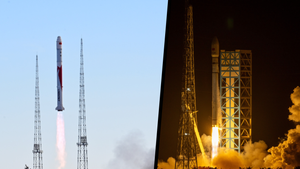
Dec 28, 2023
Pallas-1: Just a smaller Falcon 9?
Disclaimer: This article contains the opinion of the writer and not Cosmic Nxws as a whole.
Additional Disclaimer: This article contains the header image within the article in order to host the image in its full resolution as intended by Galactic Energy.
With SpaceX proving the ability to lower costs with first-stage reuse in recent years more and more companies worldwide have started their own development of partially reusable launch vehicles in the hopes of cutting down launch costs. One such company is Galactic Energy, based in China, with its medium-lift Pallas-1 rocket.
On the surface, Pallas-1 looks like a smaller Falcon 9 with a smaller payload capacity. However, looking into Pallas-1 further that is somewhat untrue. So how similar are Falcon 9 and Pallas-1?
So what is Pallas-1?
Pallas-1 is Galactic-Energy's in-development medium-lift partially reusable launch vehicle. The company currently plans to have the rocket launch from Taiyuan Satellite Launch Center and Wenchang Space Launch Site.
Pallas-1 is quoted as being able to lift up to 5,000 kilograms to low Earth orbit or 3,000 kilograms to a 700-kilometer sun-synchronous orbit. The fairing of Pallas-1 can fit a payload up to 3.8 meters in diameter and 8 meters tall.

The first-stage is powered by seven Welkin engines burning rocket-grade kerosene and liquid oxygen to generate 350 tons of thrust for up to two-minutes and fifteen seconds of burn time.
The second-stage is powered by a single Welkin vacuum-optimised engine burning rocket-grade kerosene and liquid oxygen to generate 60 tons of thrust for an undisclosed amount of time.

For recovery, Pallas-1 has four grid fins and four landing legs on the first-stage. The first-stage is planned to be landed vertically similar to LandSpace's upcoming Zhuque-3 rocket and SpaceX's Falcon 9 launch vehicle. It is currently unclear if Pallas-1 will be able to land back at its launch site.
On the pad, the rocket is 42 meters tall with the first and second stages being 3.35 meters in diameter, the fairing is 4.1 meters in diameter and tapers out from the top of the second-stage. Fully fuelled Pallas-1 weighs a believed 220,000 kilograms.
And what is Falcon 9?
Falcon 9 is currently the world's only operational partially reusable medium-lift launch vehicle. The rocket is manufactured and operated by American aerospace company SpaceX. Falcon 9 currently launches from Vandenberg Space Force Base, in California, and Cape Canaveral, in Florida.
SpaceX claims that Falcon 9 can send up to 22,800 kilograms into low Earth orbit when expended or 18,400 kilograms when reused. Similarly, it can send up to 8,300 kilograms into geosynchronous transfer orbit when expended or 5,500 kilograms when reused.
The first-stage is powered by nine Merlin 1D engines burning rocket-grade kerosene and liquid oxygen to generate 771 tons of thrust for up to two-minutes and forty-two seconds of burn time.
The second-stage is powered by a single Merlin 1D vacuum engine burning rocket-grade kerosene and liquid oxygen to generate 95 tons of thrust for up to six minutes and thirty-seven seconds of burn time.

For recovery, Falcon 9 has four grid fins and four landing legs on the first-stage. The first stage either lands vertically on a drone ship or on a landing pad back at its launch site, landing back at the launch site causes a reduction it payload capacity.
On the pad, the rocket is 70 meters tall with the first and second stages 3.7 meters in diameter, the fairing is 5.2 meters in diameter and tapers out from the top of the second-stage. Fully fuelled Falcon 9 weighs approximately 549,000 kilograms.
How do they compare?
On the surface, both vehicles look very similar, they both burn rocket-grade kerosene and liquid oxygen, both plan for first-stage reuse, and both use open-cycle, also called gas-generator, rocket engines. However, this is where the two launch vehicles' similarities end.
Pallas-1 is powered by the Welkin engine in both sea-level and vacuum-optimized versions, Falcon 9 does the same with its Merlin 1D engine. The Merlin 1D engine is larger than the Welkin engine and generates up to 100 tons of thrust, the Welkin engine is claimed to generate up to 50 tons of thrust.
Falcon 9 features ten Merlin-1D engines across its two stages, nine on the first-stage, and one on the second-stage. Pallas-1 has eight Welkin engines across the rocket's two stages, seven on the first-stage, and one on the second-stage.
Both engines utilize the open-cycle, also called gas-generator, power cycle to power the engines' turbopumps. The open-cycle, also referred to as gas-generator, is a popular and widely used power cycle in liquid rocket engines using two propellants. In this cycle, a portion of the unburned propellant is ignited in a gas generator, producing a hot gas. This hot gas is then employed to drive the propellant pumps before being expelled overboard and lost. The term open-cycle is used to describe this engine type due to the loss of exhaust gases during the process.
SpaceX is believed to be aiming to use each Merlin 1D engine one-hundred times, Galactic Energy is claiming each Welkin engine can be reused fifty times.

Despite both being medium-lift launch vehicles the two launch vehicles have vastly different payload capabilities. Pallas-1 can deliver up to 5,000 kilograms of payload to orbit and Falcon 9 can send up to 18,400 kilograms of payload to orbit, both while reused.
Falcon 9 flies payloads from most of the world, as well as crew to the International Space Station, and lowers its launch cost by launching the Starlink internet satellite constellation. Re-use of the first stage also lowers the cost of launch, the current fleet leading booster is B1058 flying nineteen times. SpaceX is believed to sell launches of Falcon 9 for roughly sixty million United States dollars.
Pallas-1 plans to fly payloads in the Chinese launch market. Currently, major launch customers in China are; satellite startups, military spacecraft, and the upcoming China SatNet constellation that will comprise of almost thirteen-thousand satellites according to The Dongfang Hour. Galactic Energy also wants to have Pallas-1 fly rideshare missions for dozens of satellites in a single launch. Currently, there is believed to not be a large enough demand for an affordable Falcon 9 like rocket.

Both rockets burn rocket-grade kerosene and liquid oxygen for a few reasons; it is safe to have people near the fuel, it's easier to keep cool compared to liquid hydrogen, and the infrastructure to produce the fuel already exists on a large scale in both China and the United States.
What causes Pallas-1 to exist?
Pallas-1, like other in-development reusable Chinese rockets, exists for a few reasons. The first is from a desire from the Chinese aerospace industry to develop reuse technology domestically using the country's existing expertise. Another reason is to cut the cost of sending payload to orbit. The third reason is due to laws preventing Chinese satellites from flying on American rockets and vice versa, preventing launch customers from accessing SpaceX launch services and others.
Conclusion on Pallas-1
It can be argued the Pallas-1 is a smaller Falcon 9 however if that is the case then so is Rocket Labs Electron, Neutron, and Stoke Space's Nova. With Galactic Energy's success with its Ceres-1 rocket, it is highly likely to be able to succeed with Pallas-1.
Pallas-1 is currently slated to fly in the second half of 2024 for its maiden flight with a first landing attempt in 2025.
Who are the companies?
This section of the article is here to provide some additional insight on SpaceX and Galactic Energy for people who may not know much about the two companies.
Who is Galactic Energy?
Galactic Energy is a private Chinese launch provider founded on the 6th of February 2018 and is headquartered in Beijing. The company currently operates the Ceres-1 solid and liquid-fuelled rocket burning solid propellants and hydrazine.
Galactic Energy is currently working on a Falcon 9 like vehicle called Pallas-1 and a potential Falcon Heavy like vehicle called Pallas-2.

Who is SpaceX?
SpaceX is an American commercial launch provider founded on the 14th of March 2002 and is headquartered in Hawthorne, in California. The company currently operates its partially reusable Falcon 9 liquid-fuelled rocket.
SpaceX is also working on its fully reusable Starship-Superheavy launch vehicle.




